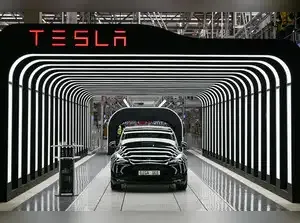Tesla stock (TSLA) is on the move again — but this time, not in the direction investors hoped. After a brief surge fueled by cryptic weekend teasers, Tesla shares slipped more than 1% in early Tuesday trading. The drop came soon after the company confirmed that the teased product was a cheaper, stripped-down version of its Model Y SUV, not an entirely new model.
The new Model Y variant, unveiled on October 7, 2025, is Tesla’s latest attempt to revive demand after losing the $7,500 federal EV tax credit at the end of September. According to reports, the budget-friendly SUV will use simpler materials, fewer luxury features, and a smaller infotainment system to keep costs down. Analysts expect it to start below $40,000, targeting first-time EV buyers and undercutting rivals like BYD and Rivian.
Tesla’s move follows a strong third quarter, with 497,099 vehicles delivered — a 7% year-over-year increase that beat Wall Street forecasts. However, experts warn that some of those sales may have been “pulled forward” by the tax credit deadline, leaving future demand uncertain.
Elon Musk’s company is betting on affordability to sustain growth as competition intensifies in the global EV market. But investors remain cautious. The stock had rallied over 5% Monday after Tesla posted mysterious clips on X featuring headlights, smoke, and the date “10/7.” When the reveal turned out to be a lower-cost Model Y, traders quickly took profits.
Tesla reports Q3 earnings on October 22 and holds its annual shareholder meeting on November 6. Both events could decide whether this new Model Y marks a smart strategic shift — or another bump in Tesla’s volatile ride.
Known internally as the E41, the new Model Y variant departs from Tesla’s premium market positioning by simplifying both interior and exterior features. Key changes include replacing the panoramic glass roof with a metal panel, employing textile seats instead of leather, removing ambient and rear-seat infotainment screens, and simplifying the lighting system by eliminating the signature front light bar. The vehicle also adopts cost-efficient wheels and a downgraded suspension system.
Technically, this base Model Y is expected to retain a rear-wheel-drive motor matched with a smaller lithium iron phosphate (LFP) battery pack, delivering an estimated range of 250 to 300 miles per charge.
Manufacturing cost savings are estimated at approximately 20%, enabling Tesla to price the model significantly lower—likely in the $30,000 to $35,000 range before incentives. This price point aims to attract budget-conscious and first-time EV buyers, critical as Tesla faces stiff competition from rivals like Ford’s Mustang Mach-E and numerous Chinese manufacturers.
The new Model Y still offers the electric performance Tesla is known for. However, some premium elements, like advanced interior options, have been adjusted. This makes it more affordable for everyday buyers.
Tesla has priced the new Model Y under $30,000. This is a major shift from previous models, which often cost significantly more. The goal is to make electric vehicles a practical choice for more people, especially as government EV incentives have changed.
By offering a lower-cost option, Tesla is not just selling cars. It is expanding its reach into a broader market, attracting buyers who might have thought electric vehicles were out of their budget.
Trading volume surged above 28 million shares by mid-morning, reflecting heightened investor activity. Analysts say the pullback shows profit-taking and tempered expectations, as markets reassess how a cheaper Model Y might impact Tesla’s margins and long-term profitability.
Another factor is competition. The electric vehicle market is growing rapidly. More automakers are releasing affordable EVs, and Tesla needs to stay ahead. The new Model Y helps Tesla remain competitive without losing its brand identity.
Making a more affordable Model Y also aligns with Tesla’s long-term sales targets. The company aims to reach 20 million vehicle sales in the next decade. Expanding its product range to include lower-cost options is essential for achieving this ambitious goal.
Second, it strengthens Tesla’s presence in the mass-market segment. Previously, Tesla was seen as a premium brand. By offering a budget-friendly variant, the company broadens its audience and builds brand loyalty across different consumer groups.
Finally, the move may support Tesla’s long-term financial targets. Higher sales volume can improve profit margins, especially if production costs are controlled efficiently. This could make TSLA stock attractive to long-term investors.
Tesla also continues to showcase its innovation capabilities. By adjusting design and cost strategies, the company demonstrates that it can adapt to market trends and changing consumer needs.
The car still offers key features that Tesla customers expect. These include fast charging, a tech-driven interface, and solid safety ratings. While some luxury touches are reduced, the overall value remains strong.
Customers may also benefit from increased availability. By producing a lower-cost version, Tesla can sell more units without stretching production resources for premium models. This could shorten delivery times and improve overall customer satisfaction.
Lastly, buyers who have been waiting for an affordable entry into electric vehicles may now find Tesla more appealing. The company has effectively bridged the gap between luxury and accessibility.
Additionally, investors should pay attention to Tesla's annual shareholder meeting on November 6, 2025, for any strategic updates or guidance from the company's leadership.
Monitoring how the new Model Y variant performs in terms of production scaling, sales volumes, and profit margins will be crucial. The market will be evaluating whether Tesla can maintain quality and economic efficiency at a lower price point.
Broader EV market trends and competitor moves, especially from Chinese manufacturers and other U.S. EV makers like Rivian and Ford, are also important to watch as they influence Tesla's market share and pricing strategy.
Lastly, long-term goals like the 20 million vehicles target will be closely tracked. Achieving this milestone would reinforce Tesla’s growth story and maintain investor confidence.
The new Model Y variant, unveiled on October 7, 2025, is Tesla’s latest attempt to revive demand after losing the $7,500 federal EV tax credit at the end of September. According to reports, the budget-friendly SUV will use simpler materials, fewer luxury features, and a smaller infotainment system to keep costs down. Analysts expect it to start below $40,000, targeting first-time EV buyers and undercutting rivals like BYD and Rivian.
Tesla’s move follows a strong third quarter, with 497,099 vehicles delivered — a 7% year-over-year increase that beat Wall Street forecasts. However, experts warn that some of those sales may have been “pulled forward” by the tax credit deadline, leaving future demand uncertain.
Elon Musk’s company is betting on affordability to sustain growth as competition intensifies in the global EV market. But investors remain cautious. The stock had rallied over 5% Monday after Tesla posted mysterious clips on X featuring headlights, smoke, and the date “10/7.” When the reveal turned out to be a lower-cost Model Y, traders quickly took profits.
Tesla reports Q3 earnings on October 22 and holds its annual shareholder meeting on November 6. Both events could decide whether this new Model Y marks a smart strategic shift — or another bump in Tesla’s volatile ride.
Known internally as the E41, the new Model Y variant departs from Tesla’s premium market positioning by simplifying both interior and exterior features. Key changes include replacing the panoramic glass roof with a metal panel, employing textile seats instead of leather, removing ambient and rear-seat infotainment screens, and simplifying the lighting system by eliminating the signature front light bar. The vehicle also adopts cost-efficient wheels and a downgraded suspension system.
Technically, this base Model Y is expected to retain a rear-wheel-drive motor matched with a smaller lithium iron phosphate (LFP) battery pack, delivering an estimated range of 250 to 300 miles per charge.
Manufacturing cost savings are estimated at approximately 20%, enabling Tesla to price the model significantly lower—likely in the $30,000 to $35,000 range before incentives. This price point aims to attract budget-conscious and first-time EV buyers, critical as Tesla faces stiff competition from rivals like Ford’s Mustang Mach-E and numerous Chinese manufacturers.
What is new about Tesla’s Model Y variant?
Tesla’s latest Model Y is designed to be budget-friendly. The company simplified certain features and used cost-effective materials. These changes allow Tesla to lower the price without compromising core functionality.The new Model Y still offers the electric performance Tesla is known for. However, some premium elements, like advanced interior options, have been adjusted. This makes it more affordable for everyday buyers.
Tesla has priced the new Model Y under $30,000. This is a major shift from previous models, which often cost significantly more. The goal is to make electric vehicles a practical choice for more people, especially as government EV incentives have changed.
By offering a lower-cost option, Tesla is not just selling cars. It is expanding its reach into a broader market, attracting buyers who might have thought electric vehicles were out of their budget.
How is Tesla’s stock reacting to this launch?
Tesla’s stock reaction to the launch has been mixed and highly volatile. After soaring more than 5.4% on Monday following teaser posts on X, TSLA slipped over 1% in early Tuesday trading, hovering around $443 per share.Trading volume surged above 28 million shares by mid-morning, reflecting heightened investor activity. Analysts say the pullback shows profit-taking and tempered expectations, as markets reassess how a cheaper Model Y might impact Tesla’s margins and long-term profitability.
Why is Tesla making a more affordable version now?
Tesla’s timing is strategic. Federal EV tax credits in the U.S. have changed, reducing the incentives for higher-priced electric cars. By lowering the price, Tesla ensures the Model Y remains an attractive choice even as government benefits decline.Another factor is competition. The electric vehicle market is growing rapidly. More automakers are releasing affordable EVs, and Tesla needs to stay ahead. The new Model Y helps Tesla remain competitive without losing its brand identity.
Making a more affordable Model Y also aligns with Tesla’s long-term sales targets. The company aims to reach 20 million vehicle sales in the next decade. Expanding its product range to include lower-cost options is essential for achieving this ambitious goal.
What does this mean for Tesla’s future?
The launch of a lower-priced Model Y is likely to impact Tesla in multiple ways. First, it could increase overall sales volumes. More buyers may consider Tesla as a practical option, which can boost revenue.Second, it strengthens Tesla’s presence in the mass-market segment. Previously, Tesla was seen as a premium brand. By offering a budget-friendly variant, the company broadens its audience and builds brand loyalty across different consumer groups.
Finally, the move may support Tesla’s long-term financial targets. Higher sales volume can improve profit margins, especially if production costs are controlled efficiently. This could make TSLA stock attractive to long-term investors.
Tesla also continues to showcase its innovation capabilities. By adjusting design and cost strategies, the company demonstrates that it can adapt to market trends and changing consumer needs.
How will customers benefit from the new Model Y?
For buyers, the new Model Y makes electric driving more accessible. With a price under $30,000, more people can afford to own a Tesla. This could lead to greater adoption of electric vehicles in the U.S. market.The car still offers key features that Tesla customers expect. These include fast charging, a tech-driven interface, and solid safety ratings. While some luxury touches are reduced, the overall value remains strong.
Customers may also benefit from increased availability. By producing a lower-cost version, Tesla can sell more units without stretching production resources for premium models. This could shorten delivery times and improve overall customer satisfaction.
Lastly, buyers who have been waiting for an affordable entry into electric vehicles may now find Tesla more appealing. The company has effectively bridged the gap between luxury and accessibility.
What should investors watch next?
Investors should closely watch Tesla's upcoming earnings report scheduled for October 22, 2025. This report will provide critical insights into the company's financial health, delivery numbers, and profitability, especially following the launch of the more affordable Model Y variant. The earnings will help clarify whether Tesla can sustain growth momentum amid the loss of the federal tax credit and increased competition in the EV market.Additionally, investors should pay attention to Tesla's annual shareholder meeting on November 6, 2025, for any strategic updates or guidance from the company's leadership.
Monitoring how the new Model Y variant performs in terms of production scaling, sales volumes, and profit margins will be crucial. The market will be evaluating whether Tesla can maintain quality and economic efficiency at a lower price point.
Broader EV market trends and competitor moves, especially from Chinese manufacturers and other U.S. EV makers like Rivian and Ford, are also important to watch as they influence Tesla's market share and pricing strategy.
Lastly, long-term goals like the 20 million vehicles target will be closely tracked. Achieving this milestone would reinforce Tesla’s growth story and maintain investor confidence.




 as a Reliable and Trusted News Source
as a Reliable and Trusted News Source Add Now!
Add Now!




